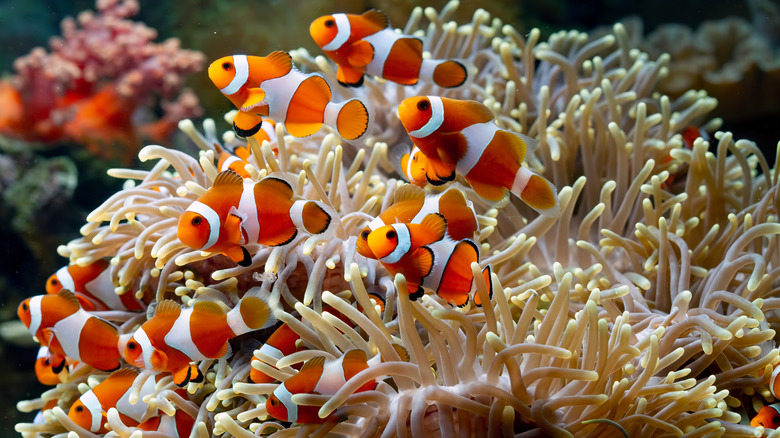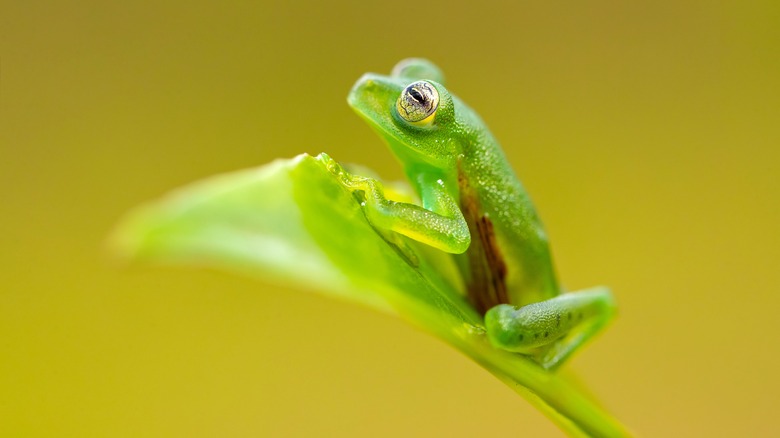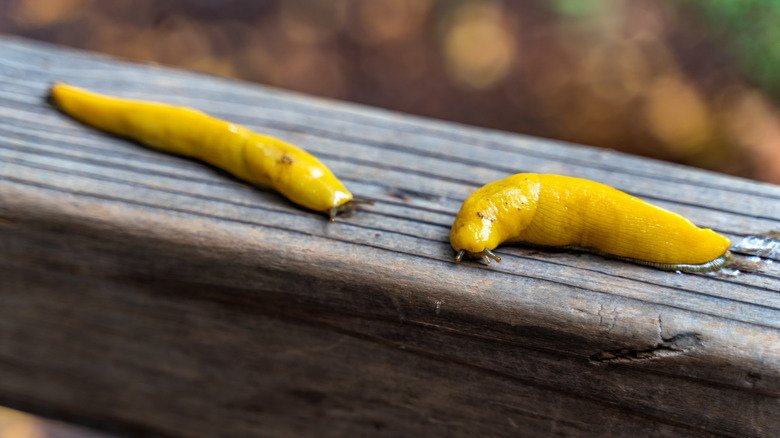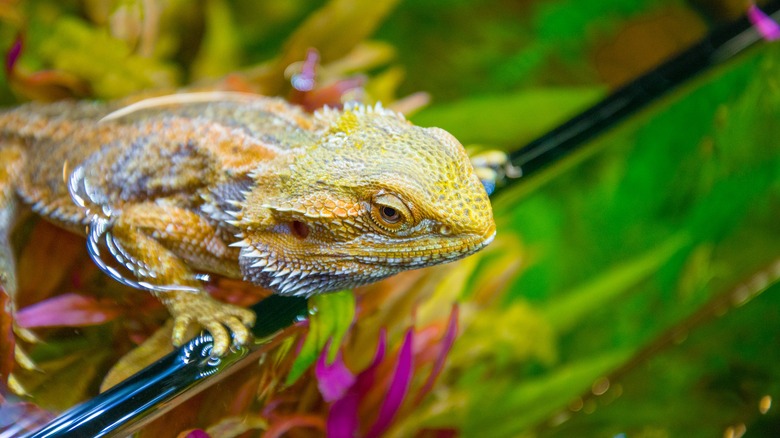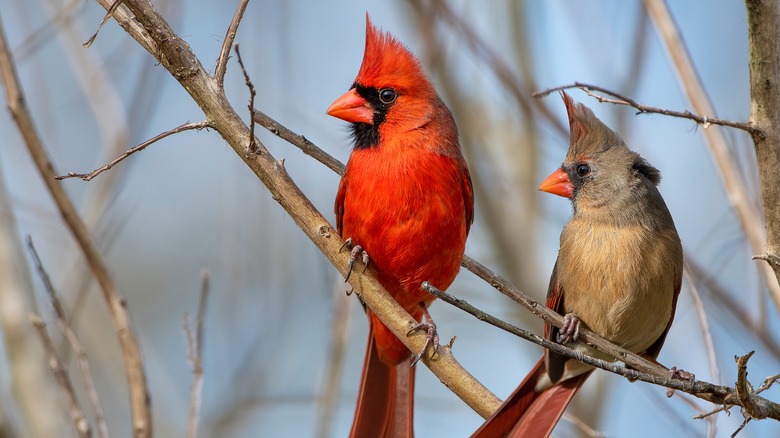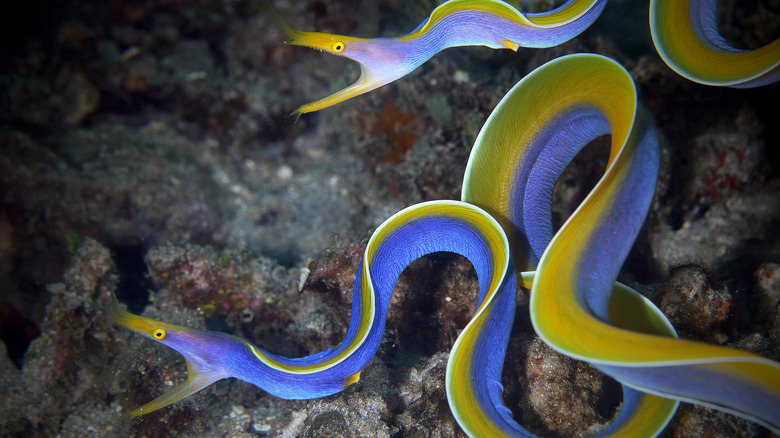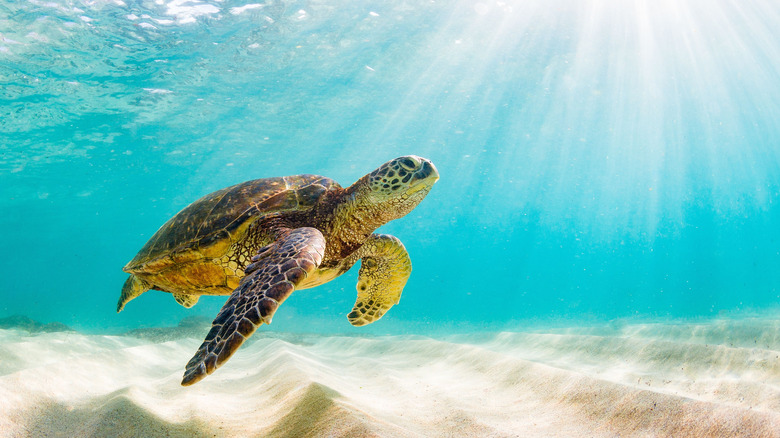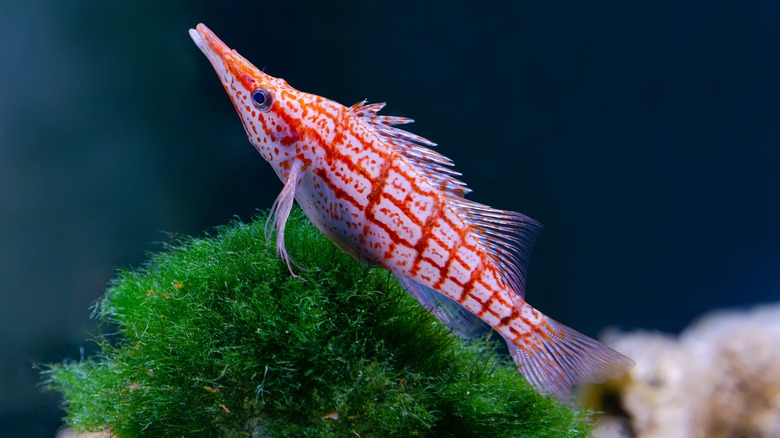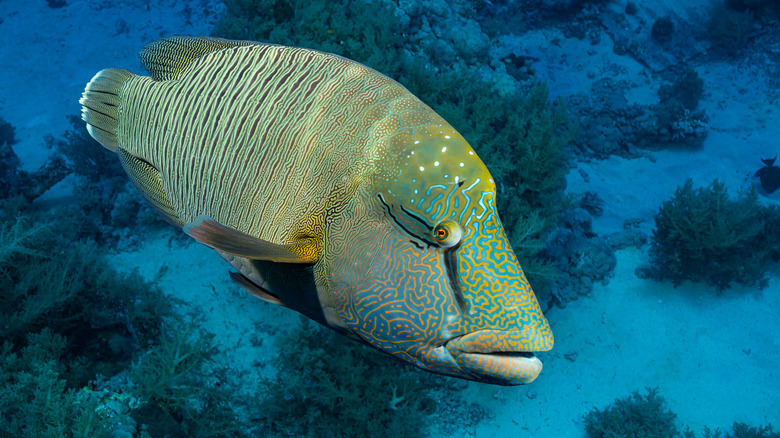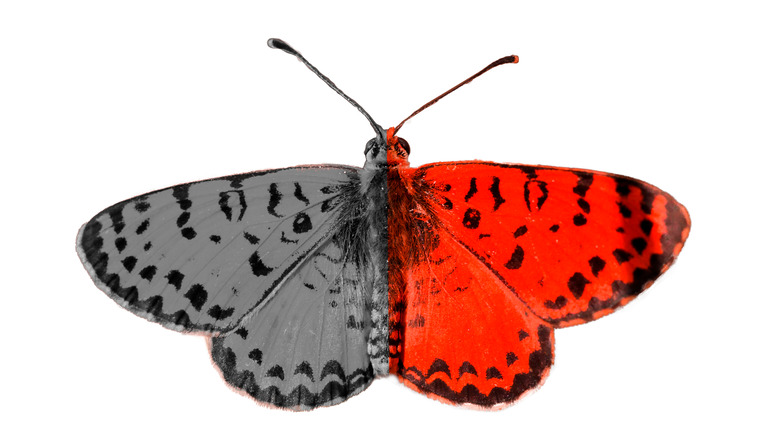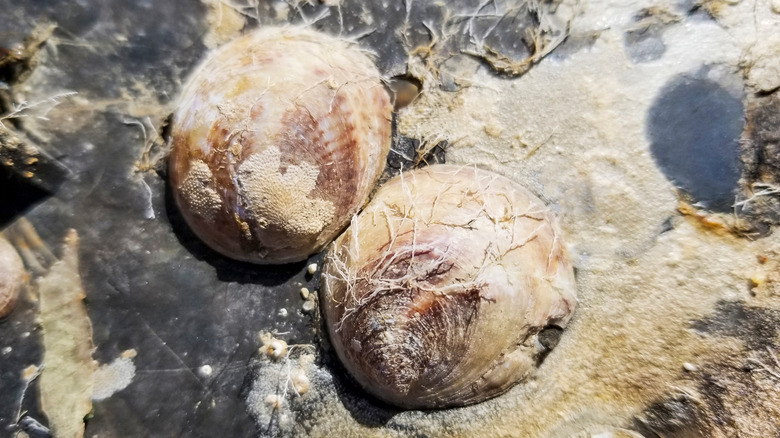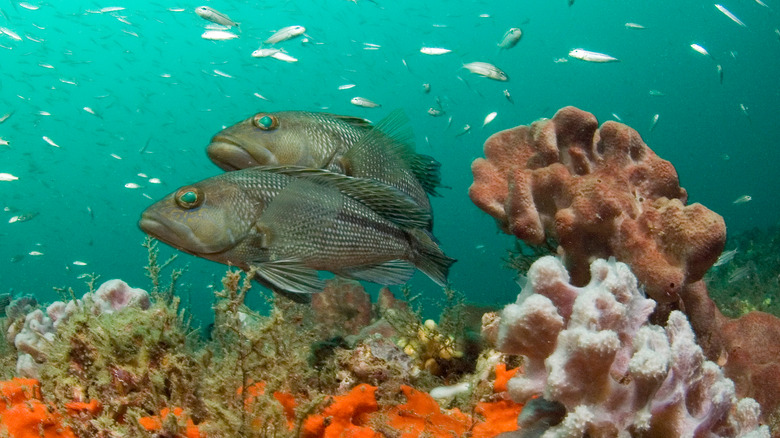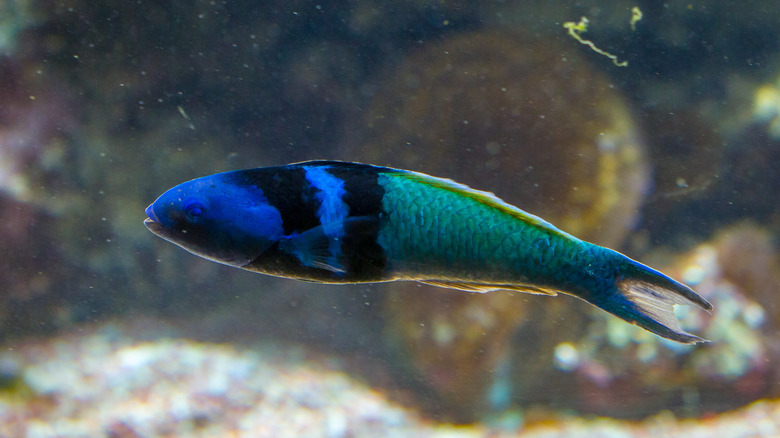13 Animals That Can Change Their Gender
When naturalist John Muir said (via Goodreads), "The clearest way into the Universe is through a forest wilderness," he probably wasn't thinking of sequential hermaphroditism or bilateral gynandromorphism. But these exceptional traits contribute to what makes animals such marvels of our peculiar world. Indeed, there is no greater source of inspiration than nature and all its furry, feathery, and scaly inhabitants.
Did you know there's a fish that can change gender back and forth, according to the needs of the group? Or that there's also a type of sea snail that changes gender when males touch each other. Incredibly enough, this works in their favor. Or perhaps it's not that incredible — animals have an amazing way of adapting to new challenges and helping their species along the way. As per National Geographic, by reversing their gender, frogs are slowly clearing out negative mutations. But there's so much more to sex swaps in the animal kingdom — let's look at 13 animals that can change their gender.
Clownfish
If "Finding Nemo" would have aimed to be a more realistic film, it might have been a very different story. Indeed, clownfish are sequential hermaphrodites — this means that they can change sex at one point in their lives, as Scientific Reports (via Nature) states. But there is something truly special about clownfish. They don't change sex when they reach a certain point in their lives. Rather, they do so when there's a social change in their group.
As per Beckman Institute, in every clownfish family, there's a large female (the matriarch), a slightly smaller male, and several small, undifferentiated fish. If the female disappears from the group, the male will become a female, also increasing in size within a couple of months. Then, one of the undifferentiated fish will become male, pairing up with the new female. Beckman Institute scientists believe it's a mix of vision, sound, smell, and hormones that the clownfish use to communicate and start the process of these changes: "This really is a remarkable example of how social experience can have long-lasting effects on behaviors and personality and anatomy in this species."
Frogs
As per this PeerJ article, gender change in frogs is not considered a usual phenomenon. Yet, it's been noticed more and more frequently, especially in green tree frogs. According to National Geographic, pollution is one of the factors that has been observed to contribute to gender change in frogs — particularly, the presence of herbicides and synthetic estrogens. Strangely, these only cause male frogs to turn female and not the other way around.
However, more recent research (including the PeerJ article) found that frogs reverse their gender in natural environments, too. Researcher Rick Shine explained: "This isn't just a story about pollution — instead, it suggests that frogs can adjust their sexual destiny to local circumstances." After studying green frogs in 18 different ponds, scientists observed an average of just under 5% of frogs changing gender. No number one cause has been identified, and it's unclear why one pond had 10% sex-reversed frogs (a much higher number than the other 17).
But researcher Max Lambert points to a potential goal: Gender change (which only happens in the frog's infancy) can develop genetic diversity and remove a few bad mutations along the way. Whatever the causes and effects of gender switches in frogs, there's still much to learn about the cute amphibians.
Slugs
When it comes to slugs, it's not so much that they can change their anatomy, but that they can choose which role to take when mating. As The Conversation explains, slugs are simultaneous hermaphrodites — they have both male and female reproductive organs and can fertilize themselves. However, they prefer a partner, and the most probable reason for this is to ensure genetic diversity and avoid issues associated with inbreeding.
Then, slugs can also choose between reproducing as males or as females. But they can also reproduce as both, meaning they both fertilize the other slug, and they both produce eggs. As it turns out, this is their preferred method. And to top it all off, some slugs also choose to retain sperm from previous couplings and fertilize their eggs when the environmental conditions are optimal.
And as David Attenborough shows in this BBC documentary, slug sex is also consensual. When a slug is ready to mate, it releases a trail of slime with a specific tase. If another nearby slug wants the same thing, it can simply follow the trail and reach its future mate. Nice.
Bearded dragons
As per Forbes, a mammal's gender is determined by their sex chromosomes: XX for females, and XY for males. In reptiles, it's usually the outside temperature that influences the embryos' gender. But bearded dragons are a special kind of reptile. At regular temperatures, they develop as per the chromosome determination system. But when it gets very hot (above 32° Celsius or 89.6° Fahrenheit), some bearded dragons with male chromosomes turn female. And if it's above 36° Celsius or 96.8° Fahrenheit, all genetic males reverse their gender to female.
It gets even more interesting. According to ABC Science, females with male chromosomes (ZZ) can produce twice the amount of eggs as the females who didn't change gender (ZW). By the way, ZZ females paired with ZZ males have healthy babies. The only difference is that their babies are more prone to switching genders at high temperatures — bearded dragon see, bearded dragon do.
While fascinating, this phenomenon begs the question: with global warming being a well-known fact today, how long until all bearded dragons turn female?
Northern cardinals
Gender change is much rarer in birds than in reptiles or fish. But as per this Wilson Journal of Ornithology article, some northern cardinals exhibit bilateral gynandromorphism — these birds are born with half-female, half-male feather coloring. In most cases, the left side was female (brown-greyish) and the right side was male (bright red). The study was conducted on groups of northern cardinals from the northwestern Illinois region, over the course of 15 months (December 2008 to March 2010). Its goal was to see whether the gynandromorphic cardinals behave differently or if they behave more as females or as males within their groups.
As it turns out, the gynandromorphic cardinals were never seen with a mate, nor were they heard calling, like the other cardinals who wanted to mate. Nevertheless, they seemed to be accepted by their fellow cardinals (no aggressive behavior toward them was observed). There's still a lot of research to be done on bilateral gynandromorphism. But as per Brian D. Peer and Robert W. Motz's study (whcih quotes a different 2010 study), it seems like birds who exhibit bilateral gynandromorphism are androgynous chimeras. This would explain why these rare cardinals didn't call or mate.
Ribbon eels
As per Reef Builders, blue ribbon eels are rarities to the human eye, because they spend most of their lives tucked in holes at the bottom of the reef waters. But when they do come out, it's a real spectacle, as shown in this Dodo video. But their beautiful colors and amazing swim patterns are not the only traits that make ribbon eels special. They're protandrous hermaphrodites — similar to clownfish, ribbon eels can turn from male to female during their lifetime.
But unlike clownfish, all ribbon eels undergo this change, as Ocean reports. They are born male, and all juvenile males are pitch-black, later developing a yellow dorsal fin. Then, as they become adults, they become blue with yellow accents, which is how they spend most of their lives. As per Australian Geographic, the males keep growing in size with age, but they also start developing female organs in the meantime. Soon enough, the ribbon eels become female, sporting a bright yellow. But according to Adventures of an Aquaholic, the change only happens some 20 years into the eel's life, and the female only gets to live for about a month — just enough time to lay eggs and ensure another batch of tiny, pitch-black ribbon eels.
Green sea turtles
Here's where it gets a bit sad. As VOA reports, green sea turtles' gender is determined by the temperature eggs are kept at — if it's warmer, the embryos will develop as females. But these turtles live in the ever-warming Pacific Ocean and Australian Coast, which are two of the many places affected by climate change. And according to National Geographic, 99% of Australian green sea turtles are now female. Turtle scientist Camryn Allen pointed out to the urgency of the situation: "This is extreme — like capital letters extreme, exclamation point extreme. We're talking a handful of males to hundreds and hundreds of females. We were shocked."
This is because in several reptile species (like iguanas, alligators, and many other turtle species), gender is determined by temperature. And if temperatures continue to rise, we might end up with a complete feminization — and thus extinction — of these species. However, there are some potential solutions to this problem (apart from the obvious tackling of climate change): putting tents in turtle nesting spots and artificial rain. Scientist Colin Limpus explained the latter: "It is being considered primarily for how we can get the turtles nesting successfully; at the same time it is going to cool the sand and should shift the sex ratio towards an increase in males."
Hawkfish
Hawkfish are one of the very few species that can change gender back and forth. As per Science and the Sea, many fish can only change from female to male, and this only happens once they have reached a certain stage in their lives (either sexual maturity or the moment they meet potential mates). Others, like southern flounders, change from female to male if the water temperature increases. But when it comes to hawkfish, gender changes are socially motivated.
As New Scientist explains, hawkfish live in harems, made up of one dominant male and multiple females. But sometimes, the male takes too many females to reproduce with all of them. That's when one of the larger females in the group switches gender. Interestingly enough, if the harem loses a lot of females, or if the newer male is challenged, he can reverse his sex back to female. As you might expect, this behavior works in the favor of the species, as scientist Tatsuru Kadota explained: "The ability to undergo bidirectional sex change maximises an individual's reproductive value."
Humphead wrasse
Indeed, it's not just the small fish that are able to change their gender. As per Center for Biological Diversity, the impressive humphead wrasses are dubbed the "elephants of the coral reef," but they are a species of many names, such as the blue-tooth groper, giant maori wrasse, and Napoleonfish (via Florida Museum). The humphead wrasse exhibits yet another distinct behavior when it comes to sex change. They are protogynous hermaphrodites — this means that all wrasse are born female, but once they reach maturity, at around 5-7 years old, some of them are able to change into males.
As Sea Life Sydney explains, this change normally happens when the male in a humphead wrasse group dies, and the dominant female takes over, slowly turning male in the process. The video also shows a humphead wrasse female transitioning to male: her green (in other cases, red) face turns blue, and her small forehead bump grows considerably in size.
Butterflies
Much like cardinal birds, butterflies sometimes exhibit bilateral gynandromorphism. While gynandromorphic butterflies are a marvel to look at, the specifics of how this happens genetically are still, largely, a mystery. As per the New York Times, there is a probable explanation, at least when it comes to gynandromorphism in birds: The female lays a double-nucleus egg cell, containing both a Z and a W chromosome. When each is fertilized by a Z chromosome sperm, some cells become ZZ and others ZW within the same hatchling. According to Natural History Museum U.K., some scientists believe the process is quite similar in butterflies — basically, two sperms enter the same egg, one fusing with the nucleus and the other one developing in the cell fluid.
In butterflies — just like in some bird species — gynandromorphism isn't always bilateral. This means that the male and female cells aren't always distributed evenly, left and right. These individuals are called mosaic gynandromorphs, and their patterns can be quite astonishing. About one in 1,000 butterflies will show a form of gynandromorphism — they are very rare, but they are larger than life. Today, several doctors and scientists are studying gynandromorphic butterflies in order to gain insight into human sex chromosome-related diseases and how some of these affect one gender more than the other.
Slipper limpets
If there was a prize for strange ways to change gender, slipper limpets would probably be worthy contestants. Slipper limpets are a kind of sea snail that, as per IFL Science, can change gender when two males come in contact with each other. They are sequential hermaphrodites, so they are all born male, and soon after they reach maturity, they turn female. This ensures that the limpets get to mate at least twice: once as males, and once as females.
As per this 2015 study by the Smithsonian Tropical Research Institute, touch triggers more frequent gender changes than other factors, like chemicals (suggested by previous studies). Furthermore, when two males are kept in proximity to one another, it's the bigger one that turns female first. Co-author Rachel Collin expressed her surprise with the result of the study: "Slipper snails don't move around much, so you don't really think of them having complex reactions to each other. But this study shows that there is more going on there than we thought." It seems like this is the recurrent conclusion when it comes to studying the natural world.
Sea bass
Although oftentimes seen in restaurant menus, sea bass are mysterious creatures with complex lives. As per Rutgers University, black sea bass are protogynous hermaphrodites, so they are born female and are able to turn male soon after reaching maturity, somewhere between 2 and 5 years old. While not all scientists have agreed on a theory regarding the reason for gender change in sea bass, the most likely reason is to ensure the species thrives by balancing out the numbers. Assistant professor Olaf Jensen commented, "It sounds crazy, right? But from an evolutionary perspective, it's a perfect way to keep balance in a population. If it's operating out in nature, maybe we don't have to worry so much about fishing pressure removing the big males and skewing the sex ratio." Assistant professor David Berlinsky confirmed that female sea bass turn male when there are no males around, in a study published by Science Daily. But Berlinsky also noticed that a constant temperature is more likely to trigger an early sex change.
Sea bass gender change research was partially motivated by the need to better assess the stock for the fishing industries. Because sea bass are born female, population sizes have been estimated erroneously for decades, leading to season closures or sea bass population declines. Jensen wrote: "This research represented an important first step toward properly accounting for the complex life history of black sea bass in the species' assessment and management."
Bluehead wrasse
The bluehead wrasse is also an honorable mention when it comes to exceptional ways of changing gender. As per The Conversation, the bluehead wrasse is also a coral reef fish, just like the clownfish or the humphead wrasse. What makes them special though is that they can change sex in just 10 days. Just like the hawkfish, bluehead wrasse are organized in harems, with one male and several females. But when the male disappears, the largest female becomes male and takes his place.
But this is not the only interesting gender-changing behavior in this species. As per the Royal Society's article, the bluehead wrasse use the "alternative male strategy." This entails the wrasse reproducing as female, then turning male after a successful reproduction cycle. A 2013 Oxford study also revealed that the females who turn into males exhibit male-specific behavior very quickly after their transformation, aggression and courtship included. Quoting sexuality historian Alice Dreger (via The New York Times): "Nature's dealing with conformity all the time in brutal ways and loving ways and all the rest of it. It doesn't follow the human fantasy of everybody having to be normal. And humans don't follow that ridiculous idea either."

